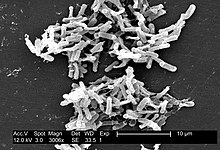 Global Information
Global InformationClostridioides difficile information
| Clostridioides difficile | |
|---|---|

| |
| C. difficile colonies on a blood agar plate | |

| |
| Electron micrograph of the bacterium | |
| Scientific classification | |
| Domain: | Bacteria |
| Phylum: | Bacillota |
| Class: | Clostridia |
| Order: | Eubacteriales |
| Family: | Peptostreptococcaceae |
| Genus: | Clostridioides |
| Species: | C. difficile
|
| Binomial name | |
| Clostridioides difficile (Hall & O'Toole, 1935) Lawson & Rainey, 2016
| |
| Synonyms | |
| |
Clostridioides difficile (syn. Clostridium difficile) is a bacterium known for causing serious diarrheal infections, and may also cause colon cancer.[4][5] It is known also as C. difficile, or C. diff (/siː dɪf/), and is a Gram-positive species of spore-forming bacteria.[6] Clostridioides spp. are anaerobic, motile bacteria, ubiquitous in nature and especially prevalent in soil. Its vegetative cells are rod-shaped, pleomorphic, and occur in pairs or short chains. Under the microscope, they appear as long, irregular (often drumstick- or spindle-shaped) cells with a bulge at their terminal ends (forms subterminal spores). Under Gram staining, C. difficile cells are Gram-positive and show optimum growth on blood agar at human body temperatures in the absence of oxygen. C. difficile is catalase- and superoxide dismutase-negative, and produces up to three types of toxins: enterotoxin A, cytotoxin B and Clostridioides difficile transferase.[7] Under stress conditions, the bacteria produce spores that are able to tolerate extreme conditions that the active bacteria cannot tolerate.[8]
Clostridioides difficile is an important emerging human pathogen; according to the CDC, in 2017 there were 223,900 cases in hospitalized patients and 12,800 deaths in the United States.[9] Although C. difficile is commonly known as a hospital and antibiotic associated pathogen, at most one third of infections can be traced to transmission from an infected person in hospitals,[10] and only a small number of antibiotics are directly associated with an elevated risk of developing a C. difficile infection (CDI), namely vancomycin, clindamycin, fluoroquinolones and cephalosporins.[11][12][13] The majority of infections are acquired outside of hospitals, and most antibiotics have similar elevated risk of infection on par with many non-antibiotic risk factors, such as using stool softeners and receiving an enema.[14]
Clostridioides difficile can also become established in the human colon without causing disease.[15] Although early estimates indicated that C. difficile was present in 2–5% of the adult population,[8] more recent research indicates colonization is closely associated with a history of unrelated diarrheal illnesses, such as food poisoning or laxative abuse.[16] Individuals with no history of gastrointestinal disturbances appear unlikely to become asymptomatic carriers. These carriers are thought to be a major reservoir of infection.[17]
- ^ Cite error: The named reference
Hall et al., 1935was invoked but never defined (see the help page). - ^ Cite error: The named reference
Prevot, 1938was invoked but never defined (see the help page). - ^ Page Species: Clostridioides difficile on "LPSN - List of Prokaryotic names with Standing in Nomenclature". Deutsche Sammlung von Mikroorganismen und Zellkulturen. Archived from the original on November 8, 2022. Retrieved November 8, 2022.
- ^ Drewes JL, Chen J, Markham NO, Knippel RJ, Domingue JC, Tam AJ, et al. (August 2022). "Human Colon Cancer-Derived Clostridioides difficile Strains Drive Colonic Tumorigenesis in Mice". Cancer Discovery. 12 (8): 1873–1885. doi:10.1158/2159-8290.CD-21-1273. PMC 9357196. PMID 35678528.
- ^ "Johns Hopkins Doctors Discover That a Common Infection May Cause Cancer". August 24, 2022. Archived from the original on May 26, 2023. Retrieved August 29, 2022.
- ^ Moreno MA, Furtner F, Rivara FP (June 2013). "Clostridium difficile: a cause of diarrhea in children". JAMA Pediatrics. 167 (6): 592. doi:10.1001/jamapediatrics.2013.2551. PMID 23733223.
- ^ Kordus SL, Thomas AK, Lacy DB (May 2022). "Clostridioides difficile toxins: mechanisms of action and antitoxin therapeutics". Nature Reviews. Microbiology. 20 (5): 285–298. doi:10.1038/s41579-021-00660-2. PMC 9018519. PMID 34837014.
- ^ a b Ryan KJ, Ray CG, eds. (2004). Sherris Medical Microbiology (4th ed.). McGraw Hill. pp. 322–4. ISBN 978-0-8385-8529-0.
- ^ "Clostridioides difficile Infection | HAI | CDC". www.cdc.gov. January 2, 2020. Archived from the original on March 8, 2020. Retrieved March 10, 2020.
- ^ Eyre DW, Cule ML, Wilson DJ, Griffiths D, Vaughan A, O'Connor L, et al. (September 2013). "Diverse sources of C. difficile infection identified on whole-genome sequencing". The New England Journal of Medicine. 369 (13): 1195–1205. doi:10.1056/NEJMoa1216064. PMC 3868928. PMID 24066741.
- ^ Guh AY, Adkins SH, Li Q, Bulens SN, Farley MM, Smith Z, et al. (October 1, 2017). "Risk Factors for Community-Associated Clostridium difficile Infection in Adults: A Case-Control Study". Open Forum Infectious Diseases. 4 (4): ofx171. doi:10.1093/ofid/ofx171. PMC 5903408. PMID 29732377.
- ^ Brown KA, Khanafer N, Daneman N, Fisman DN (May 2013). "Meta-analysis of antibiotics and the risk of community-associated Clostridium difficile infection". Antimicrobial Agents and Chemotherapy. 57 (5): 2326–2332. doi:10.1128/AAC.02176-12. PMC 3632900. PMID 23478961.
- ^ Rafey A, Jahan S, Farooq U, Akhtar F, Irshad M, Nizamuddin S, et al. (May 2023). "Antibiotics Associated With Clostridium difficile Infection". Cureus. 15 (5): e39029. doi:10.7759/cureus.39029. PMC 10266117. PMID 37323360.
- ^ McFarland LV, Surawicz CM, Stamm WE (September 1990). "Risk factors for Clostridium difficile carriage and C. difficile-associated diarrhea in a cohort of hospitalized patients". The Journal of Infectious Diseases. 162 (3): 678–684. doi:10.1093/infdis/162.3.678. PMID 2387993.
- ^ McFarland LV, Mulligan ME, Kwok RY, Stamm WE (January 1989). "Nosocomial acquisition of Clostridium difficile infection". The New England Journal of Medicine. 320 (4): 204–210. doi:10.1056/NEJM198901263200402. PMID 2911306.
- ^ VanInsberghe D, Elsherbini JA, Varian B, Poutahidis T, Erdman S, Polz MF (April 2020). "Diarrhoeal events can trigger long-term Clostridium difficile colonization with recurrent blooms". Nature Microbiology. 5 (4): 642–650. doi:10.1038/s41564-020-0668-2. PMID 32042128. S2CID 211074075.
- ^ Eyre DW, Griffiths D, Vaughan A, Golubchik T, Acharya M, O'Connor L, et al. (November 12, 2013). Chang YF (ed.). "Asymptomatic Clostridium difficile colonisation and onward transmission". PLOS ONE. 8 (11): e78445. Bibcode:2013PLoSO...878445E. doi:10.1371/journal.pone.0078445. PMC 3827041. PMID 24265690.